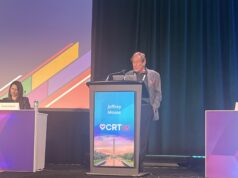 Ryan D Madder (Frederik Meijer Heart & Vascular Institute, Spectrum Health, Grand Rapids, USA) and others report in EuroIntervention that “telestenting”—ie. when the operator performs stenting in a separate location from the patient—is feasible using a robotic percutaneous coronary intervention (PCI) system (CorPath 200, Corindus Vascular Robotics). They add that additional studies are required to determine “if future advancements in robotics will facilitate telestenting over long geographic distances”.
Ryan D Madder (Frederik Meijer Heart & Vascular Institute, Spectrum Health, Grand Rapids, USA) and others report in EuroIntervention that “telestenting”—ie. when the operator performs stenting in a separate location from the patient—is feasible using a robotic percutaneous coronary intervention (PCI) system (CorPath 200, Corindus Vascular Robotics). They add that additional studies are required to determine “if future advancements in robotics will facilitate telestenting over long geographic distances”.
Madder et al report: “If telestenting were developed into a procedure capable of being performed over long geographic distances, it could be applied to improve access to PCI in medically under-served regions and might represent a novel alternative to inter-hospital transfer for primary PCI in patients with ST-segment elevation myocardial infarction (STEMI)”. Robotic PCI, the authors claim, may enable telestenting because it “only requires the operator to be present at the controls but not necessarily at the patient’s bedside”. Therefore to test this hypothesis, they assessed the feasibility of an operator performing PCI with the robotic system while in an isolated room from the patient. Communication between the operator and individuals in the cat lab was via a telecommunications system (TelePresence VX Clinical Assistant, Cisco Systems).

Of 22 lesions treated in the study (in 20 patients), 19 (86.4%) were successfully treated with telestenting. Madder et al comment: “In the three cases where technical success was not met, each required conversion to a manual procedure. In two of the unsuccessful cases, conversion to a manual procedure was required for inability to deliver a stent robotically to the target lesion after successful robotic angioplasty.” They add that procedural success—defined as <30% residual stenosis upon completion of the procedure in the absence of death or repeat revascularisation prior to hospital discharge—was achieved in 95% of patients (19) and that this rate did not differ from that of controls in a propensity-matched analysis. “There were no deaths and no instances of repeat revascularisation in any of the patients prior to hospital discharge,” the authors note.
The next step, according to Madder et al, is to determine if a wireless connection (currently not avaiable) between the robotic arm (ie. that performs the PCI) and the robotic controls would facilitate the successful performance of telestenting over long geographic distances. The authors suggest that if telestenting over long geographical distances was achievable, a second physician or physician assistant capable of performing tasks such as arterial access and diagnostic angiography would be required to be in the cath lab with the patient. They add: “This individual could also be trained to provide technical aid in the event that the robotics failed. It is conceivable that beside procedural steps might be most readily accomplished by a non-interventional cardiologist experienced in performing coronary angiography but who is not trained in PCI”.
Furthermore, Madder et al state while the safety of performing telestenting in remote locations without backup has yet to be determined, “extensive data support the safety of performing both elective and primary PCI manually without on-site surgery”.
Madder told Cardiovascular News: “It is important to recognise that this study represents a small initial step in the development of telestenting. There are many barriers to overcome to develop telestenting further, including the need for a second operator at the remote site. Who that second operator should be has not yet been determined. It is clear, however, that many remote geographic sites around the globe do not currently have access to an interventional cardiologist. This is particularly problematic when patients present to these remote sites with acute myocardial infarction.”













